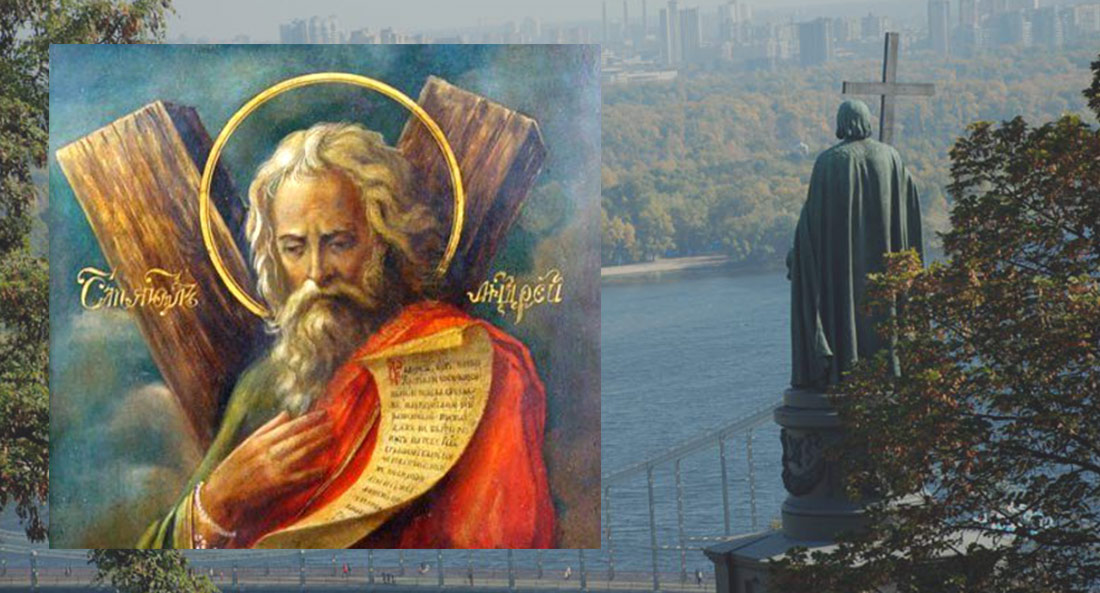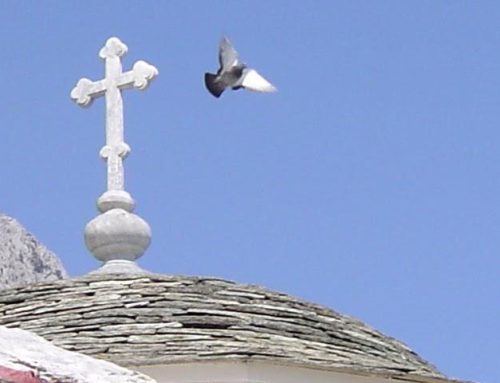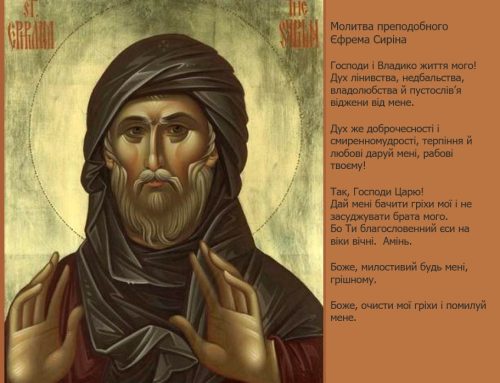THE HOLY APOSTLE ANDREW THE FIRST-CALLED
“O blessed Cross, clothed in the majesty and beauty of the Lord’s limbs!… [R]estore me to my Teacher, so that, through you, the One who redeemed me by you, may receive me. Hail, O Cross; yes, hail indeed!” (St. Andrew’s words addressed to the Cross on which he was to be crucified, according to the 6th century Passion of Andrew) Andrew bar-Jonah, younger brother of Simon bar-Jonah, the leader of Jesus’ Apostles whom Jesus called Peter, “the Rock” (Lloyd C. Douglas, author of The Robe, called him “the Big Fisherman” in the sequel by that name). Often over-shadowed by his famous brother and, like him, a fisherman, Andrew is a major hero for Ukrainians and other East Europeans for it was he who was sent to their lands to proclaim the Good News of God’s Love and Mercy.
The Povist’ vremennykh lit (Tale of Bygone Years) relates that he made his way up the Dnipro River to the hills where Kyiv now stands, planted a Cross and prophesied the rise of a great city from which the light of the Gospel would spread in the surrounding lands. The 1621 Synod, held in Kyiv as the Church of Ukraine was re-organizing following the Union of Berestya in 1596 (which led to the formation of the Ukrainian Catholic Church), issued the following declaration: “The Holy Apostle Andrew is the first Archbishop of Constantinople, Ecumenical Patriarch and Apostle to Ukraine. His feet stood upon the hills of Kyiv, his eyes beheld Ukraine, and his lips blessed her, and here he sowed the seeds of faith. Indeed, Ukraine is no less than other Eastern nations, for an Apostle preached in her as well”.
This is why St. Andrew’s College, founded in 1946, the theological school of the Ukrainian Orthodox Church of Canada, currently celebrating its centenary, chose him as its Patron. Also the third Primate of the Church, Metropolitan Andrew (Metiuk) of blessed memory, upon accepting monastic tonsure as is traditional for Orthodox Bishops, chose this name although his baptismal name was Gregory (Hryhorij) and it is customary for monks to keep the first letter of their secular name when choosing the monastic one. (His Grace, Andrij (Peshko), current Bishop of the Eastern Diocese, whose baptismal name is “Bohdan”, has done likewise.) “Andrew” is not a typical Hebrew name as is “Simon”. It is a Greek name signifying “manly”. It was not unusual for Hebrews of the day to give Greek names to their children. In the case of Andrew it was very appropriate for he played an important role in bridging the gulf between Jewish and non-Jewish followers of Jesus.
There are two narratives regarding Andrew’s becoming a Disciple of the Lord. One, recounted in both the Gospels of Matthew and Mark (and a parallel event is found in that of Luke), relates that Jesus saw them fishing and called them to become “fishers of men”. The Gospel of John, on the other hand, says that he and another Disciple were followers of John the Baptist, Jesus’ cousin, and that John’s testimony led them to Jesus. Andrew quickly recognized in Him the long-awaited Messiah and hastened to bring to Him his brother, Simon Peter. John has more to say as well. He relates that it was practical Andrew who drew attention to the boy who had five small barley loaves and two small fish when Jesus wanted to feed the huge crowd that had followed Him to the place near the Sea of Galilee where He was preaching, and at the same time noted that this was an exceedingly small amount of food for such a crowd. The Lord miraculously multiplied it so that all were fed and there were basketfuls left over. When some Greeks approached the Apostle Philip with a request to see Jesus, Philip went to see Andrew first and then they both brought them to Jesus. This event, as John relates it, appears to have been recognized by Jesus as a sign that it was time for His glorification by crucifixion to redeem the world (John 12:2-36).
After the Lord’s Resurrection and Ascension and the coming of the Holy Spirit Andrew preached in Thrace, Scythia (present-day Ukraine) and Achaia. These lands became part of the Patriarchate of Constantinople and Andrew is considered the first Bishop of that see. Today the Bishops of Rome and Constantinople (the Pope and the Patriarch) exchange greetings on the Feast days of the respective founders of their sees (Peter – June 29/July 12, and Andrew – November 30/December 13), as a sign of apostolic love and harmony, although full inter-communion remains a goal yet to be achieved.
Andrew is said to have been crucified on an X-shaped Cross (like Peter he did not consider himself worthy of dying upon a Cross like the Lord’s) in Patras of Achaia. To make his sufferings more prolonged, the governor of the city had him tied rather than nailed to it. And the stalwart Apostle preached to multitudes from his Cross, which, according to his Passion he embraced with the words given above. Many were converted and wanted to take him down from the Cross but he prayed that this would not come about and they could not. A heavenly light shone upon the crucified Apostle and when it faded he had departed the earth to be with His Lord in Paradise.
His Relics are to be found in the Orthodox Basilica of St. Andrew in Patras where they had been originally before being transferred to the Church of the Holy Apostles in Constantinople. After the sack of Constantinople by the fourth Crusader in 1204, Relics were brought to Amalfi in Italy where a Cathedral (Duomo) dedicated to St. Andrew was built. It is held that most of his Relics are still kept here. His skull was brought to Italy after the fall of Constantinople to the Ottomans. The youngest surviving son of the Byzantine Emperor, Thomas Paleologus, gave it to Pope Pius II, who had placed it in St. Peter’s Basilica. Pope Paul VI in 1964 ordered that all Relics of St. Andrew held in the Vatican be returned to Patras. That is also where the Cross on which the Apostle was crucified is found, having been returned from France where Crusaders had taken it.
We are blessed at this commemoration of the centenary of our Ukrainian Orthodox Church of Canada to have with us an Icon of St. Andrew with a tiny portion of his Relics. Through the prayers of Your Holy Apostle, O Lord, preserve and save us as we strive to continue the Mission of Your First-called Apostle. Amen. (igk)
СВЯТИЙ АПОСТОЛ АНДРІЙ ПЕРВОЗВАНИЙ
«О благословенний Хресте, одягнений у велич і красу Господнього Тіла! … [П]риведи мене знову до мого Вчителя, щоб через Тебе міг прийняти мене Той, Хто викупив мене Тобою. Вітай, Хресте; так, справд вітай!» (Слова Св. Андрія до Хреста, на якому він мав бути розп’ятий, згідно з твором з 6-го століття «Страсті Андрія»)
Андрій Бар-Йона (тобто син Йони), молодший брат Симона Бар-Йони, провідника Апостолів Ісуса, якого Ісус назвав Петром, «Скелею» (Ллойд Доґлас, автор повісті «Мантія» [The Robe], назвав його «Великим рибалкою» [The Big Fisherman] у продовженні цієї повісті). Переважно в тіні свого знаменитого брата і, як і він, рибалка, Андрій є головним героєм для українців та інших східноєвропейців, бо саме він був посланий у їхні краї проголошувати Добру Новину про Божу Любов та Милосердя.
«Повість временних літ» розповідає, що він пробрався по Дніпру до пагорбів, де зараз знаходиться Київ, посадив там Хрест і пророкував про повстання великого міста, з якого пошириться світло Євангелії на навколишні землі. Собор 1621 р., який відбувся в Києві, коли Церква України була відновлена після Берестейської унії 1596 р. (яка призвела до створення Української Католицької Церкви), видав таку декларацію: «Святий апостол Андрій – перший Архиєпископ Константинополя, Вселенський патріарх і Апостол в Україні. Його ноги стояли на київських пагорбах, його очі дивились на Україну, і його уста благословляли її, і тут він посіяв зерна віри. Дійсно, Україна не менша за інші східні народи, бо і в ній проповідував Апостол ».
Ось чому Колегія Св. Андрія, заснована в 1946 році, богословська школа Української Православної Церкви в Канаді, яка два роки тому відзначила своє сторіччя, обрала його своїм Покровителем. Також третій Предстоятель цієї Церкви, бл. п. Митрополит Андрей (Метюк), прийнявши чернечий постриг, як це традиційно для православних єпископів, обрав це ім’я, хоча його хрестильне ім’я було Григорій, і монахи звичайно приймають чернече ім’я, яке починається першою буквою їх світського імені. (Прежсвященніший Андрій (Пешко), нинішній Єпископ Східної єпархії, якого хрестильне ім’я – „Богдан“, зробив те саме.) «Андрій» – це не типове івритське ім’я, як «Симон». Це грецьке ім’я, що означає “мужній”. Для євреїв того часу не було незвичним давати грецькі імена своїм дітям. У випадку з Андрієм це було дуже доречно, оскільки він зіграв важливу роль у подоланні кордону між єврейськими та неєврейськими послідовниками Ісуса.
Є два перекази щодо того, як Андрій став Учнем Господа. Один, про який розповідається в Євангеліях від Матвія та Марка (і паралельна подія зустрічається в Луки), розповідає, що Ісус бачив, як вони ловили рибу, і покликав їх стати “рибалками людей”. З іншого боку, в Євангелії від Івана сказано, що він та інший Учень були послідовниками Івана Хрестителя, двоюрідного брата Ісуса, і що саме свідчення Івана привело їх до Ісуса. Андрій швидко впізнав у Ньому довгоочікуваного Месію і поспішив привести до нього свого брата Симона Петра. Іван має ще щось сказати. Він розповідає, що практичний Андрій звернув увагу на хлопчика, який мав п’ять ячмінних хлібців і дві маленькі рибки, коли Ісус хотів нагодувати величезний натовп, що йшов за Ним, до місця біля Галилейського моря, де Він проповідував, і водночас зазначив, що для такого натовпу це було надзвичайно мало їжі. Господь чудесним чином помножив це так, що всі були нагодовані, а залишилось чимало кошиків з кусками їжі. Коли деякі греки звернулись до апостола Пилипа з проханням побачити Ісуса, Пилип спершу пішов до Андрія, а потім обоє привели їх до Ісуса. Цю подію, як розповідає Іван, схоже, пізнав Ісус як знак того, що настав час Його прославлення розп’яттям, щоб спасти не лише євреїв а ввесь світ (Івана 12:2-36).
Після Воскресення та Вознесення Господнього та пришестя Святого Духа Андрій проповідував у Фракії, в Скифії (це включає нинішню Україну) та Ахаї. Ці землі увійшли до Константинопольського патріархату, і Андрій вважається першим єпископом цього престолу. Сьогодні Єпископи Риму та Константинополя (Папа Римський та Патріарх) обмінюються привітаннями зі святами відповідних засновників своїх кафедр (Петро – 29 червня / 12 липня та Андрій – 30 листопада / 13 грудня), на знак апостольської любові та злагоди, хоча повноцінне спілкування ще залишається метою, якої ще потрібно досягти.
Кажуть, що Андрій був розп’ятий на Хресті у формі букви «Х» (подібно як Петро, він не вважав себе гідним померти на Хресті такому ж, як був Господній) у Патрах Ахайських. Щоб зробити його страждання більш тривалими, губернатор міста наказав його прив’язати, а не прибити до нього. А непохитний Апостол проповідував багатьом зі свого Хреста, який, згідно зі своїми Страстями, він прийняв словами, наведеними вище. Багато навернулися і хотіли зняти його з Хреста, але він молився про це, щоб цього не сталося, і вони не могли зняти його. Небесне світло осяяло розп’ятого Апостола, і коли воно згасло, він пішов зі землі, щоб бути зі своїм Господом у Раю.
Його Святі Мощі знаходилися в православній базиліці Св. Андрія в Патрах, до їх перенесення до церкви Святих Апостолів у Константинополі. Після розграбування Константинополя четвертим хрестоносним походом у 1204 році, Мощі були доставлені в Амальфі в Італії, де був побудований Собор (Дуомо), присвячений Святому Андрію. Вважається, що більшість його Мощей і досі зберігаються тут. Його череп був привезений до Італії після падіння Константинополя османам. Наймолодший син візантійського імператора, Фома Палеолог, подарував його Папі Пію II, який розмістив його в базиліці Святого Петра. Папа Павло VI в 1964 році наказав повернути всі мощі Святого Андрія, що зберігаються у Ватикані, Патрам. Тут також знаходиться Хрест, на якому був розп’ятий Апостол, повернутий із Франції, де його були взяли хрестоносці.
Української Православної Церква в Канаді була благословенна в часі відзначення її сторіччя мати в Собе Ікону Святого Андрія з крихітною частиною його мощей. Молитвами Свого Святого Апостола, Господи, збережи і спаси нас, бажаючих продовжувати Місію Твого Первозваного Апостола. Амінь. (іюк)






